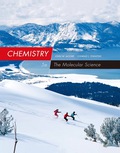
Concept explainers
(a)
Interpretation:
(a)
Explanation of Solution
Given,
Molar Mass of
Hence,
Balanced equation is given below,
Two moles of cobalt reacts with eight moles of carbon monoxide gives one mole of dicobalt octacarbonyl.
Mass in grams of dicobalt octacarbonyl is calculated as follows,
According to the gram calculation, cobalt is limiting reagent, therefore the gram of cobalt is calculated as follows,
The mass (g) of dicobalt octacarbonyl is
(b)
Interpretation:
The additional mass of the limiting reactant that is needed to react completely with the residual excess reactant has to be calculated.
(b)
Explanation of Solution
Given,
Molar Mass of
Assuming that the carbon monoxide in the final product is the only carbon monoxide used.
Mass in grams of dicobalt octacarbonyl is calculated as follows,
Excess CO is calculated as follows,
Balanced equation is given below,
Two moles of cobalt reacts with eight moles of carbon monoxide gives one mole of dicobalt octacarbonyl.
Grams of cobalt is calculated for reaction of excess carbon monoxide is given below,
Therefore,
(c)
Interpretation:
Total mass of dicobalt octacarbonyl produced from subpart (a) and (b) has as to be calculated.
(c)
Explanation of Solution
Given,
Molar Mass of
Balanced equation is given below,
Two moles of cobalt reacts with eight moles of carbon monoxide gives one mole of dicobalt octacarbonyl.
Mass in grams of dicobalt octacarbonyl is calculated as follows,
Therefore the total gram of dicobalt octacarbonyl is calculated as follows,
Total mass of dicobalt octacarbonyl produced is
Want to see more full solutions like this?
Chapter 3 Solutions
EBK CHEMISTRY: THE MOLECULAR SCIENCE
- Write a balanced equation for the reaction of hydroiodic acid, HI, with calcium hydroxide, Ca(OH)2. Then, write the balanced complete ionic equation and the net ionic equation for this neutralization reaction.arrow_forwardMany cereals are made with high moisture content so that the cereal can be formed into various shapes before it is dried. A cereal product containing 58% H2O by mass is produced at the rate of 1000. kg/h. What mass of water must be evaporated per hour if the final product contains only 20.% water?arrow_forwardYou take 1.00 g of an aspirin tablet (a compound consisting solely of carbon, hydrogen, and oxygen), burn it in air, and collect 2.20 g CO2 and 0.400 g H2O. You know that the molar mass of aspirin is between 170 and 190 g/mol. Reacting 1 mole of salicylic acid with I mole of acetic anhydride (C4H6O3) gives you 1 mole of aspirin and 1 mole of acetic acid (C2H4O2). Use this information to determine the molecular formula of salicylic acid.arrow_forward
- 3.92 Many chemical reactions take place in the catalytic con- verter of a car. In one of these reactions, nitric oxide (NO) reacts with ammonia (NH3) to give nitrogen (N2) and water. Write a balanced equation for this reaction.arrow_forwardPhosphoric acid, H3PO4, can be prepared by the reaction of phosphorus(V) oxide, P4O10, with water. 14P4O10(s)+32H2O(l)H3PO4(aq);H=96.2kJ What is H for the reaction involving 1 mol of P4O10? P4O10(s)+6H2O(l)4H3PO4(aq)arrow_forward4.69 The pictures below show a molecular-scale view of a chemical reaction between H2 and CO to produce methanol, CH3OH. The box on the left represents the reactants at the instant of mixing, and the box on the right shows what is left once the reaction has gone to completion. Was there a limiting reactant in this reaction? If so, what was it? Write a balanced chemical equation for this reaction. As usual, your equation should use the smallest possible whole number coefficients for all substances.arrow_forward
- 3.14 A number of compounds are used in cement, and reactions among them occur when water is added. In one, CaO reacts with Al2O3 and water to form Ca3Al2(OH)12. Write a bal- anced chemical equation for this process.arrow_forwardBacterial digestion is an economical method of sewage treatment. The reaction is an intermediate step in the conversion of the nitrogen in organic compounds into nitrate ions. What mass of bacterial tissue is produced in a treatment plant for every 1.0 104 kg of wastewater containing 3.0% NH4+ ions by mass? Assume that 95% of the ammonium ions are consumed by the bacteria.arrow_forwardWrite a balanced equation for (a) the combustion (reaction with oxygen gas) of glucose, C6H12O6, to give carbon dioxide and water. (b) the reaction between xenon tetrafluoride gas and water to give xenon, oxygen, and hydrogen fluoride gases. (c) the reaction between aluminum and iron(III) oxide to give aluminum oxide and iron. (d) the formation of ammonia gas from its elements. (e) the reaction between sodium chloride, sulfur dioxide gas, steam, and oxygen to give sodium sulfate and hydrogen chloride gas.arrow_forward
 Chemistry: The Molecular ScienceChemistryISBN:9781285199047Author:John W. Moore, Conrad L. StanitskiPublisher:Cengage Learning
Chemistry: The Molecular ScienceChemistryISBN:9781285199047Author:John W. Moore, Conrad L. StanitskiPublisher:Cengage Learning Chemistry: An Atoms First ApproachChemistryISBN:9781305079243Author:Steven S. Zumdahl, Susan A. ZumdahlPublisher:Cengage Learning
Chemistry: An Atoms First ApproachChemistryISBN:9781305079243Author:Steven S. Zumdahl, Susan A. ZumdahlPublisher:Cengage Learning ChemistryChemistryISBN:9781305957404Author:Steven S. Zumdahl, Susan A. Zumdahl, Donald J. DeCostePublisher:Cengage Learning
ChemistryChemistryISBN:9781305957404Author:Steven S. Zumdahl, Susan A. Zumdahl, Donald J. DeCostePublisher:Cengage Learning
 Chemistry for Engineering StudentsChemistryISBN:9781337398909Author:Lawrence S. Brown, Tom HolmePublisher:Cengage Learning
Chemistry for Engineering StudentsChemistryISBN:9781337398909Author:Lawrence S. Brown, Tom HolmePublisher:Cengage Learning Chemistry & Chemical ReactivityChemistryISBN:9781337399074Author:John C. Kotz, Paul M. Treichel, John Townsend, David TreichelPublisher:Cengage Learning
Chemistry & Chemical ReactivityChemistryISBN:9781337399074Author:John C. Kotz, Paul M. Treichel, John Townsend, David TreichelPublisher:Cengage Learning





